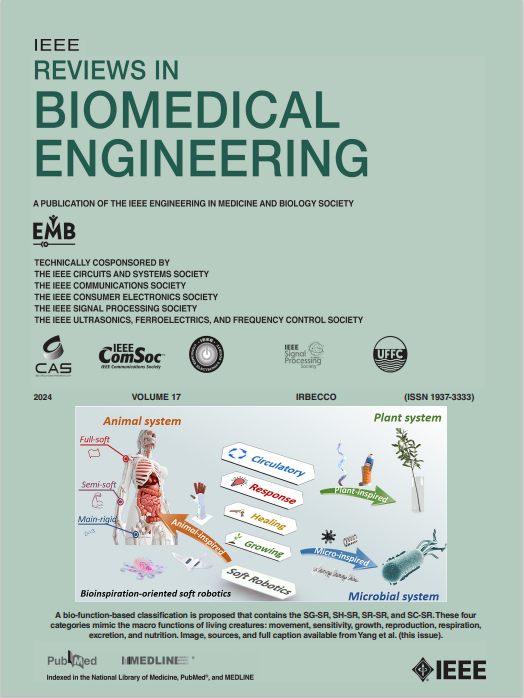开发用于心血管监测的超声可穿戴技术:从设备开发到临床验证。
IF 17.2
1区 工程技术
Q1 ENGINEERING, BIOMEDICAL
引用次数: 0
摘要
灵活、小巧、节能、坚固、用户友好的可穿戴设备的出现极大地影响了市场的增长,预计 2022 年市场价值将达到 613.0 亿美元。可穿戴传感器通过对生命参数进行连续测量,彻底改变了家庭健康监测。超声波可用于无创、安全、连续地记录生命参数。用于医疗保健的下一代智能超声波设备将微电子技术与柔性、可拉伸的贴片和人体适形设备集成在一起。它们不仅具有可穿戴性和用户舒适度,还能更准确地跟踪心血管参数的即时变化。此外,由于固定附着在皮肤上,探头放置或病人移动造成的误差也会减小,尽管在正确的解剖位置放置仍很关键,并且需要使用者的技能和知识。本综述讨论了将可穿戴超声系统引入医疗市场所需的步骤(技术、设备开发、信号处理、实验室验证,最后是临床验证)。下一代血管超声及其未来的研究方向为血管健康评估的现代化以及家庭和临床监测的个性化护理质量提供了多种可能性。本文章由计算机程序翻译,如有差异,请以英文原文为准。
Towards Ultrasound Wearable Technology for Cardiovascular Monitoring: From Device Development to Clinical Validation
The advent of flexible, compact, energy-efficient, robust, and user-friendly wearables has significantly impacted the market growth, with an estimated value of 61.30 billion USD in 2022. Wearable sensors have revolutionized in-home health monitoring by warranting continuous measurements of vital parameters. Ultrasound is used to non-invasively, safely, and continuously record vital parameters. The next generation of smart ultrasonic devices for healthcare integrates microelectronics with flexible, stretchable patches and body-conformable devices. They offer not only wearability, and user comfort, but also higher tracking accuracy of immediate changes of cardiovascular parameters. Moreover, due to the fixed adhesion to the skin, errors derived from probe placement or patient movement are mitigated, even though placement at the correct anatomical location is still critical and requires a user's skill and knowledge. In this review, the steps required to bring wearable ultrasonic systems into the medical market (technologies, device development, signal-processing, in-lab validation, and, finally, clinical validation) are discussed. The next generation of vascular ultrasound and its future research directions offer many possibilities for modernizing vascular health assessment and the quality of personalized care for home and clinical monitoring.
求助全文
通过发布文献求助,成功后即可免费获取论文全文。
去求助
来源期刊

IEEE Reviews in Biomedical Engineering
Engineering-Biomedical Engineering
CiteScore
31.70
自引率
0.60%
发文量
93
期刊介绍:
IEEE Reviews in Biomedical Engineering (RBME) serves as a platform to review the state-of-the-art and trends in the interdisciplinary field of biomedical engineering, which encompasses engineering, life sciences, and medicine. The journal aims to consolidate research and reviews for members of all IEEE societies interested in biomedical engineering. Recognizing the demand for comprehensive reviews among authors of various IEEE journals, RBME addresses this need by receiving, reviewing, and publishing scholarly works under one umbrella. It covers a broad spectrum, from historical to modern developments in biomedical engineering and the integration of technologies from various IEEE societies into the life sciences and medicine.
 求助内容:
求助内容: 应助结果提醒方式:
应助结果提醒方式:


